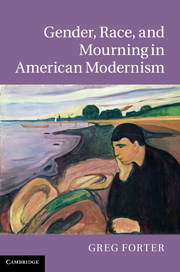Book contents
- Frontmatter
- Contents
- Acknowledgements
- Introduction
- 1 Gender, melancholy, and the whiteness of impersonal form in The Great Gatsby
- 2 Redeeming violence in The Sun Also Rises: phallic embodiment, primitive ritual, fetishistic melancholia
- 3 Versions of traumatic melancholia: the burden of white man's history in Light in August and Absalom, Absalom!
- 4 The Professor's House: primitivist melancholy and the gender of utopian forms
- Afterword
- Notes
- Index
Introduction
Published online by Cambridge University Press: 21 April 2011
- Frontmatter
- Contents
- Acknowledgements
- Introduction
- 1 Gender, melancholy, and the whiteness of impersonal form in The Great Gatsby
- 2 Redeeming violence in The Sun Also Rises: phallic embodiment, primitive ritual, fetishistic melancholia
- 3 Versions of traumatic melancholia: the burden of white man's history in Light in August and Absalom, Absalom!
- 4 The Professor's House: primitivist melancholy and the gender of utopian forms
- Afterword
- Notes
- Index
Summary
This book approaches canonical modernism in the USA as a response to changes in the sex/gender and racial systems that took place between 1880 and 1920. The authors I discuss experienced these transformations largely in the mode of loss; they felt themselves cut off, that is, from the form of white manhood that had been dominant in the years prior to 1880. They responded to this loss in what I show was a melancholic manner. Their works attempted to grieve the loss, but the grief was characterized by a deep ambivalence and unconscious aggression that crippled and blocked the work of mourning. My chapters trace the vicissitudes of this dynamic in major works by four authors: F. Scott Fitzgerald's The Great Gatsby (1925), Ernest Hemingway's The Sun Also Rises (1926), William Faulkner's Light in August (1932) and Absalom, Absalom! (1936), and Willa Cather's The Professor's House (1925).
Each of these works fantasmatically “works over” the historical materials it engages. Each of them gives a highly condensed, allegorical account of the processes endangering nineteenth-century white manhood, and each enacts a specifically aesthetic kind of melancholic grief. Nevertheless, a set of real, historical transformations subtends these aesthetic engagements. It may be helpful to begin by sketching the relevant processes in some detail.
- Type
- Chapter
- Information
- Gender, Race, and Mourning in American Modernism , pp. 1 - 14Publisher: Cambridge University PressPrint publication year: 2011



